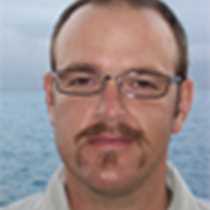Santiago Island
As we receive each new day we find the sun rising, this morning over Santiago Island, a “new day” in many ways. Santiago has struggled with invasive species that would have ended in the loss of biodiversity of this unique ecosystem, however there has been an impressive turnaround. We landed at Espumilla Beach onto fine eroded ash with organic sand and immediately we found Pacific green sea turtle tracks from the previous evening. This beach holds one of the largest nesting areas in Galápagos, and we found egg casings from recently hatched turtles as we started our hike inland. Almost immediately we encountered the bleached bones of Capra hicrus - the common goat. This island would have become a desert if it were not for the help of various institutions including Lindblad Expeditions and National Geographic; we have adopted this island with our guests to help remove invasive species. As all large invasive mammals have been removed, the island is returning to its previous grandeur, which includes the propagation of unique species of endemic Scalesia plants that were believed to be extinct. Along the path mockingbirds, Darwin finches, and Galápagos hawks made their morning conversations. We came to a viewpoint looking down through a forest of incredibly large incense trees peeking through to our anchorage.
A small group of kayakers explored the coast close to Espumilla beach eventually returning for breakfast along with our hikers. Captain Pablo repositioned National Geographic Islander a few minutes away from our morning site to a place called Buccaneers’ Cove. This beach was used by early sailors to careen their ships so they could fix broken hulls and also land on Santiago to obtain fresh water in season and giant tortoises for food. We finished our morning visit with a combination of Zodiac rides along the rugged coast and deep water snorkeling. All were content especially those that were able to swim with the sea lions, rays, and large aggregations of fish in the deep blue water.
The afternoon brought more surprises as we hiked in the footsteps Darwin. Landing on a black sand beach we readied ourselves for a hike along the coast of Puerto Egas. This site had a small human population up until the 1960s. Salt mining was the main activity mixed with fishing, however the area was abandoned and eventually reverted to the Galápagos National Park that was created in 1959. As the sun lowered in the horizon we were delighted by the life of the outer coast. Galápagos fur seals previously on the brink of extinction seemed to be relaxed in healthy numbers along the coast. The fur seal grottos, which are collapsed lava tubes, allowed us to spot green sea turtles and yellow crowned night herons. The layers of the geological past are found exposed at the coast with basalt lava flows intertwined with ash layers. Large marine iguanas were soaking up the last rays of the sun as they piled together to retain heat into the evening. Semi palmated plovers, American oystercatchers, ruddy turnstones among many other shorebirds are busy feeding in the low tidal zone. As we return to our landing beach and eventually to our home, National Geographic Islander, we found young sea lion pups not more than a few weeks old playing in the golden glow of the sunset. Time continues on its path and we feel lucky to be able to be accepted as part of this process we call life.




